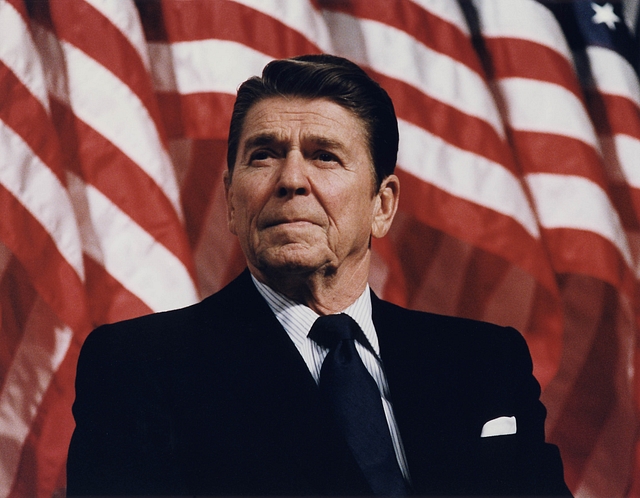
Why is Reagan Still So Popular
There is a reason conservatives keep going back to Ronald Reagan. In 1980 Ronald Reagan asked that famous question “Are you better off than you were four years ago?” in the debate with Jimmy Carter. Reagan went on to win a landslide. In 1984 Reagan won an even bigger landslide. He won 49 out of 50 states. Walter Mondale just about won his home state to stop a complete white wash.
Since 1988 , when he left the white house, the Reagan myth has only grown.
Those who watched the Republican convention in 2012 must have seen Mr Romney’s now famous statement “This president cannot tell us that you’re better off today than when he took office” – a throwback to 1980.
Even during his “Hope and Change” campaign in 2008 then Senator Barack Obama paid homage to the late president. “I think it’s fair to say that the Republicans were the party of ideas for a pretty long chunk of time there over the last 10 to 15 years in the sense that they were challenging conventional wisdom,” Obama said. “He just tapped into what people were already feeling, which was we want clarity we want optimism, we want a return to that sense of dynamism and entrepreneurship that had been missing.” ( source: Reno Gazette Journal)
It’s very interesting to see Obama saying the Republicans were the party of ideas for a “pretty large chunk of time”. That’s the key to understand the enduring appeal of the 40th president. When Ronald Reagan took office US was losing ground both at home and abroad. There was a stagflation. Economist Arthur Okun coined a new term called Misery Index , the sum of inflation and unemployment. Till then the Keynesians used to say recession and unemployment could not take place simultaneously.
But this “impossibility” was unfolding before the eyes of the American people as unmistakable reality every time they went to the gas station or the grocery store. Misery Index reached almost 20 towards the end of President Jimmy Carter’s tenure. Bruce Bartlett, an advisor to Ronald Reagan, discusses the almost definitive account of the problem and its solution in his “The New American Economy”. Some economists started to study the stagflation and the Misery Index and arrived at a solution that defied the orthodoxy of the time. Their solution was the “Supply Side Economics” popularly known as “Reaganomics”.
They saw that inflation was carrying more and more people in to higher tax brackets. A typical American family would pay 20% taxes in the beginning of the seventies and almost twice the amount towards the end of the decade ( source: Frumforum.com). Supply-siders came up with a policy prescription. Cut taxes so that a typical family has more money to spend. Tighten money to break the back of inflation.
Economist Robert Mundell , a founding father of supply-side economics went on to win the Nobel Prize in 1999. One of his key insights – inflation was very connected to the monetary policy. A tight money policy would break the back of inflation (source: ncpa). Reagan gave a free hand to Paul Volcker, the Federal Reserve chairman, to implement a tight money policy. It succeeded. From 12.5 percent in 1980, inflation fell to 8.9 percent in 1981, and 3.8 percent in 1982 (source:nro.com). In 1984 alone real economic growth boomed by 6.8%, the highest in 50 years and unemployment fell to 5.3% by 1989 ( source: forbes.com) .
The roaring successes of Reaganomics alone would have earned Reagan a place in history. But he did much more. He correctly guessed an arms race with the USSR would be a burden on the communist country that it could not afford.
As USSR stagnated under Leonid Brezhnev Reagan’s Strategic Defence Initiative ( popularly called Star wars) forced USSR to spend up to 25% of its GNP on defence. As a Stanford study shows – A central instrument for putting pressure on the Soviet Union was Reagan’s massive defense build-up, which raised defense spending from $134 billion in 1980 to $253 billion in 1989. This raised American defense spending to 7 percent of GDP, dramatically increasing the federal deficit. Yet in its efforts to keep up with the American defense build-up, the Soviet Union was compelled in the first half of the 1980s to raise the share of its defense spending from 22 percent to 27 percent of GDP, while it froze the production of civilian goods at 1980 levels.
The moth eaten USSR soon collapsed – Reagan’s successor George H W Bush presided over the freedom of the East Block countries from Soviet colonialism. The Gipper deservedly got the credit for bringing about the collapse of the tyrannical regime he evocatively called the “evil empire”.
Yes, Barack Obama was right. Ronald Reagan made sure Republicans were the party of ideas.
*****************************************************************************